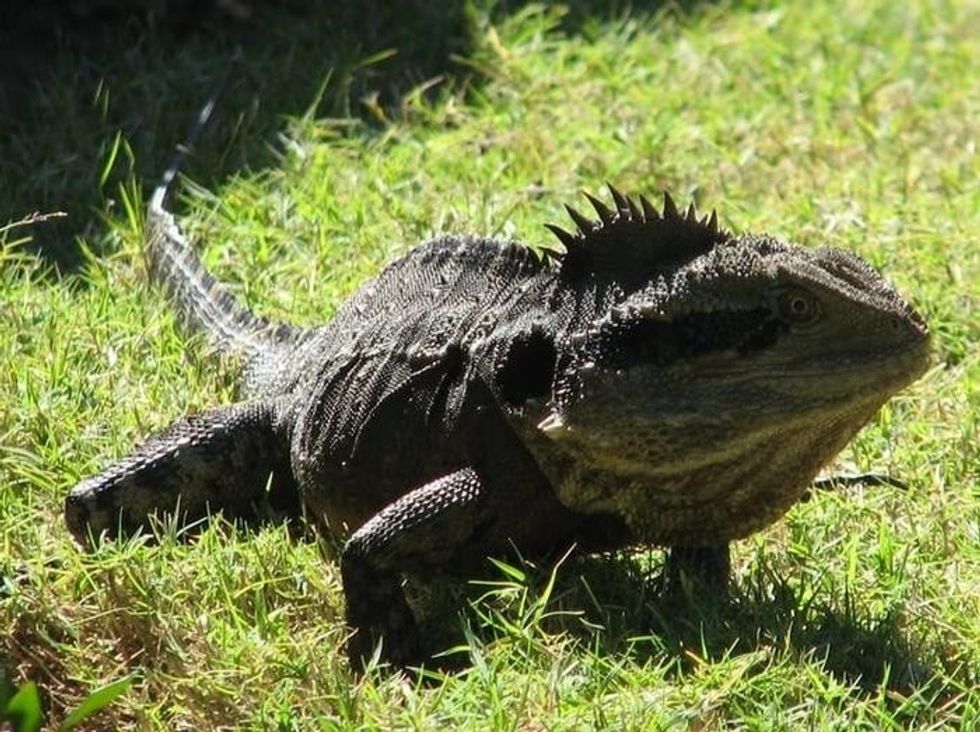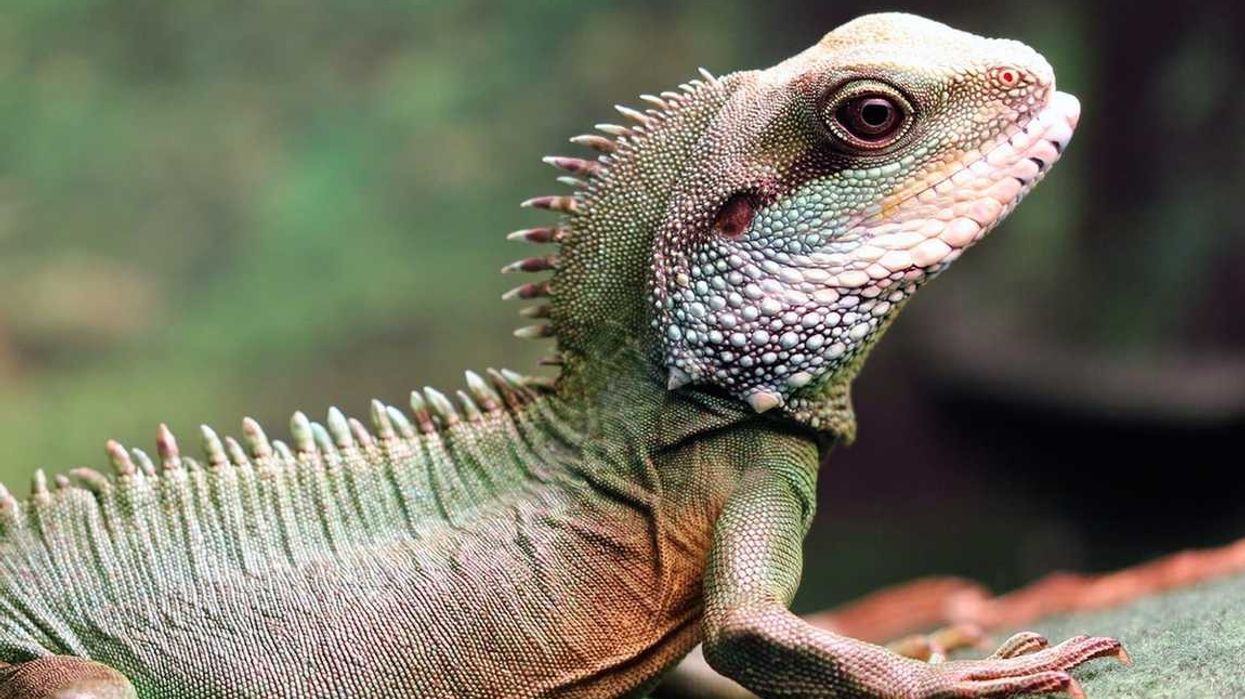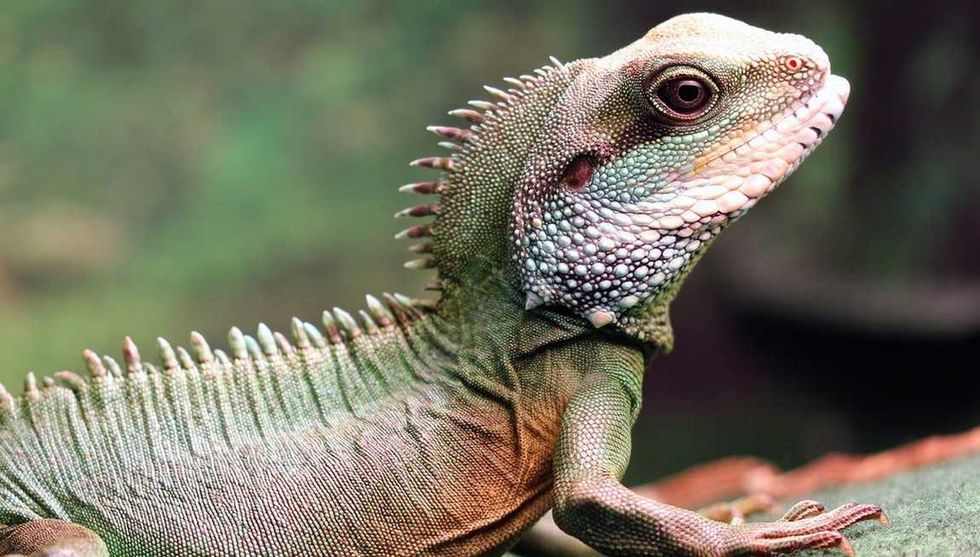Fun Water Dragon Facts For Kids
The Chinese water dragon (species physignathus) is categorized into the species of agamid lizard that is found in Southern China and other related countries of Southeast Asia. The other names for Chinese water dragon are Asian water dragon, green water dragon, Australian water dragon, and Thai water dragon.
Their body coloration can range between green or turquoise. Some water dragons have purple-colored bodies with an orange stomach.
Chinese water dragons have diagonal strips of turquoise or green on their body. The tail would be banded green or white from the middle to the end.
The undersides are very pale green, very pale yellow, or off-white. The most attractive part of their body would be their throats, which are very colorful with blue, purple, or peach colors.
Some have single colors, and some have stripes. Their tail is over two thirds of their body length and can be used as a weapon, for balance or to assist in swimming.
The Australian water dragon (Physignathus cocincinus) has long and strong limbs and claws for climbing, and its tail is long muscular laterally compressed which aids in swimming. Chinese water dragons have light greenish-gray-colored bodies with black bands on their back, tail, and legs.
They can change color to camouflage with their surroundings. Chinese water dragons are further divided into two subspecies which are Eastern Water Dragon and Gippsland Water-Dragon.
Here are some interesting Australian water dragon facts for you to enjoy. Thereafter, do read our other articles on frilled lizard and lungfish as well.
Water Dragon Interesting Facts
What type of animal is a water dragon?
The Asian water dragon (Physignathus cocincinus) is a type of lizard or an iguana. It is found around freshwater lakes and streams or on the trees surrounding the lakes or streams. They can swim in the waters below. They can’t be seen from a distance as they have apparent and transparent skin.
What class of animal does a water dragon belong to?
The green water dragon (order squamata family agamidae) belongs to the reptile class of animals. They are a type of lizard with the ability to swim and hold their breath underwater. They have a large head with a frilled crest that is just behind it, making them unmissable.
How many water dragons are there in the world?
The species of Asian water dragon (class reptilia) has a near-threatened status due to loss of natural habitat and illegal pet trade. Because of its unique features and vibrant colors, the Asian water dragon has huge demand in exotic pet markets.
This has led to their population declining in the natural habitat. However, it would be difficult to ascertain the exact number of Asian water dragons both in their natural habitat and as pets due to the reasons mentioned above.
Where does a water dragon live?
The Asian water dragon is mostly found around freshwater lakes or streams in the Southeast Asian region and Australia. They are known to spend most of the time on trees.
They spend most of their time on trees. They can be located in humid climes in more temperate zones. An adult water dragon can be found in urban settings too, with a source of fresh water nearby.
They are kept as pet animals in many urban setups. During summer and spring, the water dragon is an active animal and engages in a behavior called basking. Basking means foraging for food or swimming.
During the winter months, the water dragon will create a burrow near a water source and pack it with dirt to keep warm. They will enter a stage of brumation which slows down the metabolic rate when hibernating.
What is a water dragon's habitat?
The water dragon is found in the south of China and other southeast Asian countries like Thailand, Vietnam, Laos, Cambodia, and Burma. The Australian water dragon is found on the eastern coast of Victoria, north to Queensland. There may be a small population introduced on the southeast coast of South Australia.
Who do water dragons live with?
The water dragons are known as solitary creatures. They can be kept as a pet alone in a house too. They are not known to make groups or pairs, apart from during the mating season. In order to express aggression they use head bobbing, plus they puff up the throat, and arm waving.
How long does a water dragon live?
The water dragon lives for 10-20 years of age. They may live longer in captivity. The Chinese water dragon may live for 10-20 years. The Australian water dragon may live up to 20 years and they live in groups comprising one to two adult males and multiple females.
How do they reproduce?
The male water dragon sexually matures at the age of five, and the female water dragon may start laying eggs at the age of four. The spring season is their mating season too.
To prove their male dominance, two male water dragons may fight over a single female by circling others and biting at their hip and neck region. This may go on for 10 minutes.
The male water dragons court their female mates by physical displays, like bobbing their head. They will also latch to the female water dragon crest on their head while mating.
After this, the female water dragon digs a burrow of several inches where it lays its clutch of 6-18 eggs. These eggs hatch after 60-75 days of incubation.
The sexual activity of the water dragon is dependent on the climatic changes and temperature of their nest site. The hatchlings are one inch wide and five to six in long.
They are born independent and fully developed. They stay around the nest during the initial period and slowly start moving further away.
The hatchlings are known to stay distant from the adult population during their initial days. The water dragon is known to reproduce via parthenogenesis too, which is a natural form of asexual reproduction in which the growth of the embryos happens without fertilization by sperm.
What is their conservation status?
The conservation status of water dragons is vulnerable. More and more people are trying to stabilize the population of these species in the natural habitat as well as in the pet industry.
Water Dragon Fun Facts
What do water dragons look like?
The water dragons are a species of lizards or iguanas that mostly stay on trees and can swim in water, too. They are known for their vivid skin colors and crests.
The water dragon is found in south-east Asian countries, including China and also in the South of Australia. The Chinese water dragon is a dark light green colored lizard with high horn scales which are found from its head to tail.
The Chinese water dragon also has a small, iridescent, photo-sensitive spot between its eyes which is known as the pineal eye.
This pineal eye thermoregulates its body by sensing different light. This parietal eye can also help them against predators from above or help them awaken from a deep sleep suddenly.

How cute are they?
The water dragons are very attractive due to their brilliantly colored bodies. They are born with many different colors, out of which the dark and light greens are common ones. Some are also born with purple-colored bodies with different colored markings or crests. This makes them extremely cute and likable.
How do they communicate?
The water dragon is known to use its arms in a waving way as a gesture of appeasement or to communicate with other dragons. They will move their front leg in a circular motion with the palm outward to communicate with others. When they are aggressive, they are known to communicate with head bobbing, throat puffing, and even chasing.
How big is a water dragon?
The water dragon is bigger than most of the house lizards we usually find in our homes. They are known to extend to a length of one meter or 3.3 feet. Out of which two thirds is their tail. They are long creatures that require wide space to stay.
How fast can a water dragon move?
The water dragon is known to run at the speed of 30 mph. They are known to swim at a fairly fast speed too.
How much does a water dragon weigh?
The water dragon weighs around 2.2 lb.
What are their male and female names of the species?
Water dragons don't have specific names for their male and female counterparts.
What would you call a baby water dragon?
The baby water dragon may be called hatchling initially and later juveniles.
What do they eat?
The water dragons are omnivores, so their diet changes according to their size. The younger water dragons eat insects like ants, crickets, caterpillars, and spiders.
As they grow older, the water dragon can eat small rodents, such as baby mice, birds, small fish, and invertebrates, along with the vegetation and occasional eggs. They will also eat mollusks and small crustaceans. The water dragon has pointed teeth and a sticky tongue, which helps them catch prey for their diet.
They can forage for food while they are underwater. In captivity, they are known to get bored of one type of food served repeatedly and therefore are known as picky eaters.
Are they poisonous?
The water dragons are not poisonous. However, if angered, they may bite, which could be dangerous as they have pointed teeth. It is advised to approach them cautiously.
Would they make a good pet?
The water dragons are kept as pets due to their exotic and colorful skin. They make a good pet if they are well-taken care of and have a large space for themselves with very little noise and few people.
They are known to live alone and therefore enjoy being the center of attraction. However, if possible, they should be as close as possible to their natural habitats.
Did you know...
If the water dragon senses any danger on the trees, they will jump in the water and can remain therein for a prolonged duration of up to 90 minutes. They are known to run and jump pretty fast and swim fast too. The water dragon can stand on its hind legs to blend completely with its surroundings.
Male and females can get aggressive and are known to bob their heads, puff up their throats, and wave their arms.
The water dragons can regenerate their tails. Their total length can extend up to one m. The water dragons are known to shed their skins from time to time, especially when they grow from juveniles to adulthood.
The water dragons’ back legs are strong, and they can jump, leap, climb, and swim with them. They can run bipedally on their back legs.
Their tails are used for climbing and balance, also for swimming, and as a weapon against predators.
When the population of water dragons is high, the males may get a bit territorial and aggressive towards other males and can display behaviors like posturing, chasing, and fighting.
They are known to communicate through gestures like saluting, substrate licking, but these actions have not been fully interpreted by the scientist so far.
Different types of water dragon
There are two types of water dragons. One is the Chinese water dragon found in the south of China and other southeast Asian countries.
The other is the Australian water dragon which is found in the southern region of Australia. They have two subspecies which are known as Eastern water dragon and Gippsland water dragon.
Both the species are active during the day. The Australian water dragons are similar in appearance, with a deeply angular head and a dorsal ridge of scales extending from their heads to tails. They also have larger jowls and ears that are almost as big as their eyes.
The eastern water dragon is brownish grey with black stripes on the dorsal ridge. The Gippsland water dragons are also light greenish-grey in overall color, with black bands running across their legs, tail, and back.
Do people keep water dragons as pets?
People do keep them as pets. The water dragon can cost around $50. They are good pets as they do not have too many demands. And the water dragon does look exotic with its brilliant colors and long tail.
They are considered harmless to humans in any way. However, if they are disturbed, they may bite you, which could be a cause for concern. Otherwise, they are ideal pets who may take some time to be friendly with their owners due to their shy nature.
Here at Kidadl, we have carefully created lots of interesting family-friendly animal facts for everyone to discover! Learn more about some other reptiles including sand lizard facts, or bog turtle.
You can even occupy yourself at home by drawing one on our water dragon coloring pages.
We Want Your Photos!
More for You
Doctorate specializing in Veterinary Medicine

Oluniyi AkandeDoctorate specializing in Veterinary Medicine
With an accomplished background as a Veterinarian, SEO content writer, and public speaker, Oluniyi brings a wealth of skills and experience to his work. Holding a Doctor of Veterinary Medicine degree from the University of Ibadan, he provides exceptional consulting services to pet owners, animal farms, and agricultural establishments. Oluniyi's impressive writing career spans over five years, during which he has produced over 5000 high-quality short- and long-form pieces of content. His versatility shines through as he tackles a diverse array of topics, including pets, real estate, sports, games, technology, landscaping, healthcare, cosmetics, personal loans, debt management, construction, and agriculture.
Disclaimer
1) Kidadl is independent and to make our service free to you the reader we are supported by advertising. We hope you love our recommendations for products and services! What we suggest is selected independently by the Kidadl team. If you purchase using the Buy Now button we may earn a small commission. This does not influence our choices. Prices are correct and items are available at the time the article was published but we cannot guarantee that on the time of reading. Please note that Kidadl is a participant in the Amazon Services LLC Associates Program, an affiliate advertising program designed to provide a means for sites to earn advertising fees by advertising and linking to Amazon. We also link to other websites, but are not responsible for their content.
2) At Kidadl, we strive to recommend the very best activities and events. We will always aim to give you accurate information at the date of publication - however, information does change, so it’s important you do your own research, double-check and make the decision that is right for your family. We recognise that not all activities and ideas are appropriate for all children and families or in all circumstances. Our recommended activities are based on age but these are a guide. We recommend that these ideas are used as inspiration, that ideas are undertaken with appropriate adult supervision, and that each adult uses their own discretion and knowledge of their children to consider the safety and suitability. Kidadl cannot accept liability for the execution of these ideas, and parental supervision is advised at all times, as safety is paramount. Anyone using the information provided by Kidadl does so at their own risk and we can not accept liability if things go wrong.
3) Because we are an educational resource, we have quotes and facts about a range of historical and modern figures. We do not endorse the actions of or rhetoric of all the people included in these collections, but we think they are important for growing minds to learn about under the guidance of parents or guardians.







